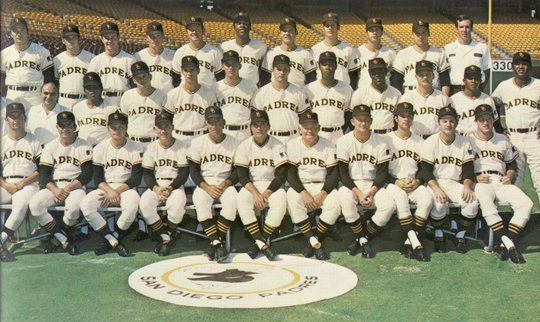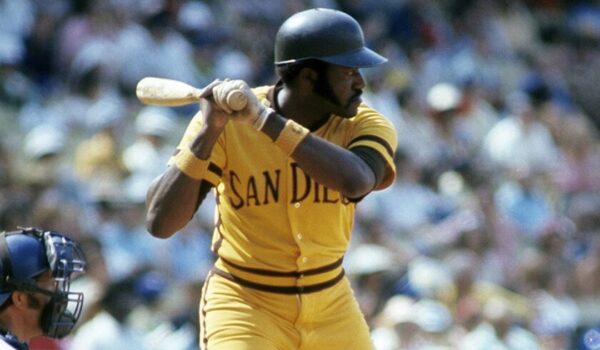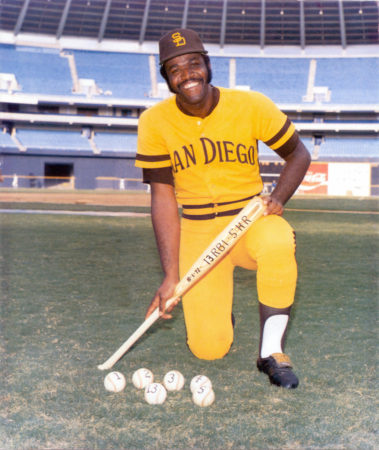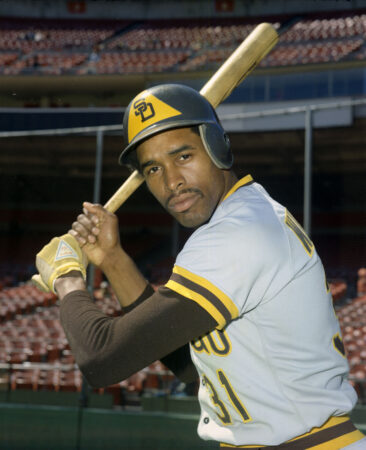The history of the San Diego Padres: Volume 1 (1969-1973)

The 1969 San Diego Padres

1972
58-95 (6th place)
Manager- Preston Gomez/Don Zimmer
All-Star- Nate Colbert (1B)
There was only one major trade in preparation of the 1972 season. The Padres traded Dave Roberts, one of the team’s better pitchers, to the Houston Astros for second baseman Derrick Thomas and pitchers Bill Greif and Mark Schaeffer. Thomas and Greif were prospects and expected to blossom in San Diego. In an attempt to boost ticket sales, Buzzie Bavasi formed the Padres Action Team. The attempt was to sell partial-season tickets at a discounted rate. The team issued a goal of 800,000 total fans for the 1972 season.
The 1972 Padres’ roster was one of the youngest in the league averaging around 24 years of age. There were high hopes for the team coming into the season. Because of a strike at the beginning of the year, the Padres lost nine games on the season. The players in the league wanted to extend the arbitration process to resolve salary disputes. Owner’s conceded, and on April 15, 1972, the season began. Clay Kirby beat Phil Niekro in a 6-5 game in which 15,000 witnessed the Padres’ win.
A 4-7 record to begin the season resulted in the Padres falling to last place early in the year. A change was needed. Buzzie Bavasi fired Preston Gomez with a 180-316 overall managerial record. The team named third base coach Don Zimmer as the replacement for Gomez. Zimmer provided a fiery attitude for the young team. The Padres responded by winning eight of their first 14 games with him at the helm.
The team played much better, and the fans began to show up in the stands. Over 104,000 fans came out to San Diego Stadium to watch a seven-game series with the Cincinnati Reds and Los Angeles Dodgers. The Padres would win three of those games, including two shutouts by pitcher Fred Norman. In the team’s first 19 games, the franchise drew over 196,000 fans. Slowly, the city of San Diego was starting to show support for their hometown team.

A 10-game losing streak in late May and early June crippled the Padres, but they remained out of the cellar. Bavasi traded Ollie Brown to the Oakland Athletics for Curt Blefary and Mike Kilkenny as the veteran outfielder fell out of favor with the staff. In June, the Padres sat with the number one pick in the entire draft. 1972 first-round pick Dave Roberts from the University of Oregon signed on June 7 with the Padres and played in his first professional game later than evening in the 12th inning against the Pittsburgh Pirates. He started his first game at third base a few days later and played in a total of 100 games for the Padres that season. Roberts went on to put up a .244/.275/.321 batting line, clearly showing issues with major league pitching. In the 5th-round of the draft, the Padres selected a left-handed pitcher named Randy Jones, who went on to have a terrific career for San Diego.
On June 25, the Padres fell into last place in the division with a 21-41 record. Steve Arlin was pitching well for the club, recording seven wins for the team by late June. On July 18, the pitcher took a no-hitter into the ninth inning against the Phillies. With two strikes, Denny Doyle bounced a single over Dave Roberts head to break up the bid. Rumor has it that Don Zimmer brought Roberts in at third base just before the pitch, and if he had not done that, the ball would have been an easily fielded ground ball for Dave Roberts.
Nate Colbert made national news on August 1 as the first baseman slugged five home runs, drove in 13 runs, and recorded 22 total bases in a doubleheader against the Braves in Atlanta. The five homers in a day equaled the total of Stan Musial, who accomplished the feat in 1954. Ironically, Colbert, a native of St. Louis, was at the game when Musial slugged five homers. Colbert enjoyed a great 1972 season, but the rest of the team suffered injuries. Steve Arlin developed a sore shoulder, and Clay Kirby missed time with an elbow injury. To make matters worse- Cito Gaston, Dave Campbell, and Leron Lee all succumb to the injury bug as well.
The Padres finished last in the division with a .379 winning percentage. If not for the 13-day strike at the beginning of the season, the team would have surely lost 100 games. Steve Arlin finished with a 10-21 record on the season, making 37 starts and pitching 250 innings on the year. Nate Colbert slammed 38 home runs and drove in 111 runs for San Diego in a coming-out year for the slugging first baseman. The Padres drew 644,272 fans to the stands, which was short of their goal established before the season. The team enjoyed the increases of over 86,700 fans from the previous season but expected more in the future. Buzzie Bavasi acknowledged that the team needed to produce on the field.
1973
60-102 (6th place)
Manager- Don Zimmer
All-Star- Nate Colbert (1B)
There were strong rumors that the Padres intended to move to Washington D.C., but on December 22, 1972, the team announced their intentions to remain in San Diego for the 1973 season. The city of San Diego agreed to help boost ticket sales and promote the team. The Padres Action Team needed help, and they got assistance from a high source within the community. Mayor Pete Wilson got behind the club, proclaiming, “This is a good young club… and it deserves public support.”
Manager Don Zimmer felt that the club was capable of finishing at or above the .500 mark. The team’s goal was to get out of the cellar for the first time in franchise history. For the fourth time in five seasons, the Padres won their opening game. This time the Padres beat the Los Angeles Dodgers 4-2 in front of 32,019 fans. At the time, that was the fifth-largest crowd to attend a major league game at San Diego Stadium. The celebrations did not last long for the club as the team finished April with a record of 7-15 and again in last place.
Nate Colbert signed for $70,000 in 1973 and only homered once in his first 22 games. The slugger would suffer a down year on the season, and the early trend was an indication of that. Many important figures regressed for the team, including pitcher Steve Arlin who was dispatched to the bullpen after a slow start to the season. Dave Roberts, the phenom number one selection from the previous season, continued his struggles at the plate. He was demoted to Triple-A at one point by the Padres.
The Padres only managed to win 20 of their first 58 games, falling 17 games from first in the standings. The franchise drew 142,000 fans to the stadium through its first 15 home games. That was a slight increase from the year before, but still well behind all the other teams in the National League. In June, the Padres selected Dave Winfield from the University of Minnesota with the 4th overall selection in the draft. The lanky outfielder/pitcher showcased amazing physical tools on the ballfield. On June 19, Winfield made his debut for San Diego, throwing out a runner at second base and recording his first hit. He went on to hit safely in each of his first six games as a professional.

Financial issues continued to power the Padres moves off the field. The team traded pitcher Fred Norman to the Cincinnati Reds for outfielder Gene Locklear, pitcher Mike Johnson, and cash consideration. The Padres also sent Dave Campbell to the St. Louis Cardinals for Dwain Anderson and cash. Randy Jones was recalled from the minors to take the place of Norman in the rotation.
At the All-Star break, the Padres stood with a 33-65 record and 29 games behind the first-place Los Angeles Dodgers. The Padres team consisted of many first and second-year players, but they could not find a cohesive group capable of winning ballgames consistently. The team was enjoyable to watch at times, but the fans were still not showing up in the stands. In September, 1,413 fans witnessed a game between the Astros and Padres, which is a franchise low.
The Padres drew 611,826 fans in total on the season. Well short of their goal. A 60-102 record was mainly to blame. The Padres finished last in the NL in team batting average (.244), RBI’s (516), and runs scored (516). Nate Colbert led the team with a disappointing 22 home runs and 79 RBI’s. John Grubb did hit .311 for the club and played well in centerfield. Rookie Dave Winfield hit .277 in 56 games producing a .714 OPS. Clay Kirby went 8-18 with a 4.79 ERA in a down year for the pitcher. Randy Jones went 7-6 with a team-leading 3.16 ERA showing San Diego a glimpse of what he was capable of doing on the mound.
Rumors of a move to Washington were at a boiling point now as the Padres seemed destined to move east. The Topps baseball card company began production of cards with a Washington logo for Padres’ players. It would take a miracle for the team to remain in America’s Finest City.
Volume II coming soon.
James was born and raised in America’s Finest City. He is a passionate baseball fan with even more passion towards his hometown Padres. Editor-In-Chief of EastVillageTimes.com. Always striving to bring you the highest quality in San Diego Sports News. Original content, with original ideas, that’s our motto. Enjoy.